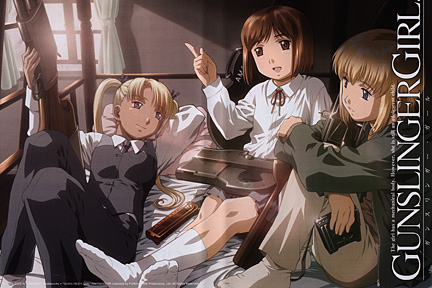
Girls modified into cyborgs still face the challenges of teenhood in "Gunslinger Girl."
Machine girls tug
at human hearts
Some of the most touching and tragic stories across cultures deal with children. And when tragedy occurs, the ones usually most affected are adults, who sigh about young lives cut short, about opportunities that could have been but will never be.
 But what happens when the children themselves know just as well how very heartbreaking their lives are -- and can't do anything about it?
But what happens when the children themselves know just as well how very heartbreaking their lives are -- and can't do anything about it?
The manga "Gunslinger Girl," by Yu Aida, tells of a department called the Social Welfare Agency within the Italian intelligence community. Its publicized purpose is to help physically challenged children. In reality the agency modifies those children into cyborgs and trains them to be anti-terrorist assassins for the government.
All the cyborgs so far are girls, although it's not made clear whether boys would work just as well.
Each girl is partnered with a "handler," who gives the child a name and is responsible for her training and how much chemical brainwashing, called "conditioning," is given. The children's physical abilities are enhanced, while the conditioning ensures that they will obey orders and protect their handler.
Each handler's outlook on the care of his cyborg differs. These differences intertwine closely with the girls' struggles to live with their new roles, and these aspects drive the story.
The story gets heavily political at times and can be hard to follow, but the focus is always on the gun-slinging girls.
DESPITE their conditioning, the cyborgs have distinct personalities. The story centers on five girls and their handlers:
» Henrietta, who was the only survivor of a butchering that killed the rest of her family. She was raped repeatedly, and an arm and leg were hacked off in the attack. Her handler, Giuseppe, wonders if choosing her as his partner was more out of pity. In any case, he is the kindest of the handlers, giving Henrietta gifts and trying to introduce her to the more wonderful things in life -- a meal at a classy restaurant, a vacation in Sicily.
» Rico, who was born with deformed limbs and spent most of her time in a hospital bed, causing constant fights between her parents. They gave her up to the agency on her 11th birthday. Her new body allows her freedom she never knew before, making Rico grateful for her life at the agency and perhaps the most obedient. Her handler, Jean, sees her as a mere tool, meant to fulfill a job, and is mostly emotionally detached from her.
» Triela, who seems to be the oldest. Not much is said about how she came to be at the agency other than that she was found in Amsterdam. Her handler, Hillshire, gives her little of the conditioning, and so she is less devoted to him and more independent-thinking than some of the other cyborgs. Although Hillshire cares about Triela, he is uncertain about how exactly to treat her. That uncertainty rubs off on his cyborg, making Triela wonder how she should act with him.
» Claes, whose life at the agency is one of solitude. Her old self loved to read, but little else is revealed about her background. Her early time is told in a flashback, in which her former handler, Raballo, proved to be a gruff but kindhearted man who ultimately bit off more than he could chew.
» Angelica, whose father tried to kill her so he could collect on her insurance to avoid bankruptcy. She was the first cyborg, when conditioning was in its experimental stages. The eventual side effects of those early drugs cause a complete turnaround in her handler Marco's attitude; he changes from a caring man to a harsh slave driver.
EACH STORY in "Gunslinger Girl" brings to light another anguishing aspect of the girls' roles and development at the agency, exploring the burdens and beauty of youth. Adolescents are the best for molding, but they still experience the changes that most girls go through -- and no amount of conditioning can erase that.
Some in the agency, especially handlers such as Giuseppe, know that this is all done to fulfill a mission but can't help having qualms about youngsters experimented on and used for such purposes.
And some of the girls know it themselves. Henrietta makes the most passionate but simple case, when some adults at the agency admonish her to be "just a regular girl." "Is a girl with a mechanical body 'ordinary'?" she says. "Since I'm a cyborg, and have to protect Giuseppe, I can't be an ordinary girl."
The mechanical way in which the girls are treated is almost repulsive. When Claes' shoulder becomes dislocated in a test, she is sent out "for repairs." Later, agency officials decide to change her conditioning to make her "useful" to them again.
The girls' conflicts show that no matter what conditioning or training is given, human emotions always lurk beneath the surface. Even the matter-of-fact Rico can't hide her youthful curiosity when, during their missions, she and Jean visit places she's never seen before, and she speaks with the disarming frankness of a child.
But there are two sides to every story, and "Gunslinger Girl" also introduces terrorists with consciences. Renowned bomb maker Franca, part of the radical group Padania, will not stand for unnecessary killing of innocents. In perhaps the most ironic moment in the story, Franca accidentally bumps into Henrietta after a mission that unknowingly involved the older woman. As the girl walks away, Franca says, "Protecting children like her is what Padania is all about."
These twists and turns on every level ensure that "Gunslinger Girl" will have the same effect on your heart.
In contrast, the corresponding anime -- the second DVD of which was released stateside this month -- starts off disappointingly. The repetitive, mix-and-match of past and present events in the first two episodes, rather than the straightforward account as in the manga, is wholly confusing.
Thankfully, the series picks up from there. It also fills in and expands the story at some parts, so it's worth a watch.
The first volume of the manga was released in October 2003, but the second didn't see light for well more than a year, finally being published last March. ADV representative David Williams explained the delay at Kawaii Kon, citing licensing issues, but adding that ADV will finish whatever series they begin. So far, the company has kept that promise; the third manga was released in June.
E-mail to Features Desk
[News] [Business] [Features] [Sports] [Editorial] [Do It Electric!]
[Classified Ads] [Search] [Subscribe] [Info] [Letter to Editor]
[Feedback]
